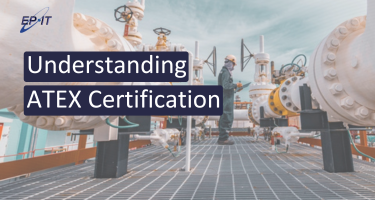 Add My Company
Add My Company

ATEX certification is more than a regulatory requirement—it’s a critical safeguard for industries operating in environments where explosive atmospheres may exist. But what does ATEX certification entail, why is it necessary, and how can businesses ensure compliance? Here’s a comprehensive guide to understanding ATEX certification.
What is ATEX Certification?
The term “ATEX” originates from the French phrase ATmosphères EXplosibles. ATEX certification ensures that equipment and protective systems are safe to use in potentially explosive environments. These environments include areas where flammable gases, vapours, mists, or combustible dusts are present, posing significant risks if not properly managed.
Key Aspects of ATEX Certification
Scope: ATEX certification applies to both individual equipment and entire workplaces, covering electrical and non-electrical equipment, as well as protective systems.
Standards: ATEX is based on two European directives:
- Directive 2014/34/EU, which governs equipment design and manufacturing
- Directive 1999/92/EC, which focuses on workplace safety.
Hazardous area classification: A zone system categorises hazardous areas based on the frequency and duration of explosive atmospheres:
- Zone 0/20: Continuous presence of explosive atmospheres.
- Zone 1/21: Likely presence during normal operations.
- Zone 2/22: Occasional presence.
Equipment design: ATEX-certified equipment must be engineered to prevent ignition sources, such as sparks, high temperatures, or static electricity.
Testing and certification: The certification process involves rigorous testing and evaluation by notified bodies designated by the European Union.
The role of notified bodies
Notified bodies are independent organisations authorised by the European Union to assess products for ATEX compliance. Their responsibilities include:
- Evaluating equipment designs for conformity with ATEX directives.
- Conducting ignition risk testing.
- Certifying that the product meets essential safety requirements.
Examples of notified bodies include TÜV Süd, SGS, and DNV, among others. Collaborating with a notified body can be a mandatory step in obtaining certification for high-risk zones.
Maintenance and Inspection Post-Certification
Achieving ATEX certification is not a one-and-done process. Ensuring ongoing safety and compliance requires businesses to stay vigilant. Regular inspections are essential to identify wear and tear, potential ignition risks, or environmental changes that could compromise equipment performance. Adhering to manufacturer-recommended maintenance schedules helps preserve the integrity of certified equipment, ensuring it continues to operate safely in hazardous environments.
If significant modifications are made to equipment, re-certification may be necessary to verify that safety standards are still met. Additionally, employees must be trained to understand how to safely operate, inspect, and maintain ATEX-certified equipment. Proper training fosters a culture of safety and ensures that equipment is used as intended. Neglecting these steps can erode safety standards over time and increase the likelihood of accidents.
Dispelling Common Misconceptions
ATEX guarantees absolute safety: While ATEX significantly reduces risks, proper handling, maintenance, and adherence to safety protocols remain essential.
It’s only for explosive gases: ATEX also applies to flammable dusts and fibres.
All ATEX labels are equal: Equipment must match the specific zone and category requirements for its intended use. For example, a product certified for Zone 2 might not be suitable for Zone 0 conditions.
By understanding these nuances, businesses can make informed decisions and avoid costly mistakes.
Benefits for Stakeholders
ATEX certification delivers value across multiple stakeholder groups. For employees, it ensures a safer work environment by significantly reducing the risks of injury or fatality associated with hazardous conditions. Employers benefit by minimising legal liabilities and operational disruptions, while also protecting critical infrastructure and assets. Regulators view ATEX compliance as a demonstration of adherence to stringent safety standards, helping businesses avoid fines or sanctions. Insurers, recognising the reduced risks associated with certified equipment, often simplify approval processes and may offer lower premiums to compliant organisations. Finally, customers and partners gain confidence in the company’s commitment to safety and reliability, fostering trust and strengthening professional relationships. Together, these benefits highlight why ATEX compliance is not merely a legal formality but a cornerstone of operational excellence.
Industries Requiring ATEX Certification
Industries operating in hazardous environments rely heavily on ATEX-certified equipment to ensure safety and compliance. Common examples include:
- Oil and gas: Refineries and offshore platforms with flammable gases.
- Chemical processing: Plants handling explosive materials.
- Pharmaceutical: Facilities using flammable solvents and substances.
- Mining: Underground operations susceptible to explosive gases and dust.
- Food and beverage: Grain silos, flour mills, and distilleries.
- Waste management: Recycling centres and composting sites producing flammable gases.
The Importance of Compliance
Failing to use ATEX-certified equipment can lead to devastating consequences. Non-compliant equipment can ignite hazardous atmospheres, causing explosions and fires with the potential for catastrophic loss of life, as seen in historical oil & gas, and mining disasters. The legal and financial implications of such incidents are severe, often resulting in hefty fines, legal actions, and irreparable damage to a company’s reputation. Operationally, accidents disrupt production and significantly impact profitability, making compliance essential. To mitigate these risks, businesses should conduct thorough hazardous area classification audits, collaborate with reputable notified bodies for certification, implement robust maintenance and staff training programmes, and review existing equipment to ensure alignment with relevant directives.
By prioritising ATEX certification and ongoing compliance, you protect not only your workforce but also your business reputation and assets in hazardous environments. For more guidance, get in touch with experts at EPIT or book your ATEX course online.
For more information on Understanding ATEX Certification: Essential for Safety in Hazardous Environments talk to EPIT Group
